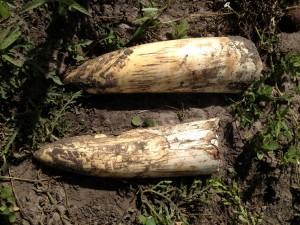Chilli Pepper Workshop by James Stevens
March 5, 2014What happens when vulnerable species are also pests? By James Stevens
April 18, 2014The hazards of fieldwork – By James Stevens
For the past six weeks or so I have spent most of my time visiting farmers’ fields after elephants have raided them. During a visit I walk around the field to identify where the elephants have entered, how many have entered and to measure their hind foot length to get estimates of age. Some of the fields I visit are right next to the Boteti river and as there have been good volumes of rain this year the river is quite high in places and submerging some of the fields. When visiting some fields one morning I was wading through the field with water up to my knees when all of a sudden the ground below me disappeared and I was up to my neck in water. Returning to chat to some of the farmers soaking wet they dually informed me that there was an old well in the corner of the field where they used to get water when the river was dry. Having had two phones in my pocket and a GPS I was less than impressed and it is now one of the first questions I ask when visiting fields near the river to see if there are any old wells.
On a side note, phones in a bag of rice for a couple of hours does the trick nicely.
On another occasion when visiting a field that had been raided on numerous occasions the farmer was very keen to show me something in the field. When we arrived at the spot I found broken elephant tusks lying on the
ground. It looked like the tips had broken off through natural causes (many of the elephants in our study area have broken tusks). Not really knowing what to do I phoned the wildlife officers that I know who work on the gate we use to enter the park. The officer in charge was not at the gate at the time but I was informed that it would be ok to bring them to the office. Obviously with the seriousness of poaching I was a little concerned of driving around with a broken ivory in my vehicle so phoned a few more times just to confirm that this would be ok. They say all publicity is good publicity but I wasn’t convinced an elephant researcher being caught with ivory would ever look good. Eventually we took the ivory to the wildlife office and had it registered and it will be sent to the governments stockpile for safekeeping.
Later in the day I had time to reflect and started thinking more about the tusks. They must have weighed close to 10kg. The going rate for ivory on the black market per kilo is $2,200. No matter how terrible poaching is you start to see why people get involved. It is easy money with very few repercussions. The local poacher takes all the risks and if caught often faces jail whereas the ringleader can often pay the minimal fine. When you are faced with the need to feed your family you can see why people turn to poaching. Solving this human-wildlife conflict problem is a key step in combating poaching. Most poaches don’t want to kill wildlife but they have no other option at times through desperation. By reducing human-elephant conflict, allowing farmers to feed their families, the communities that border national parks are less likely to turn to poaching.

